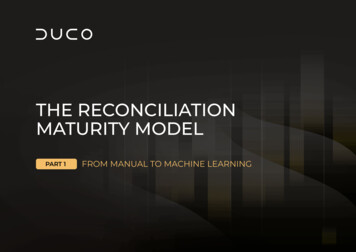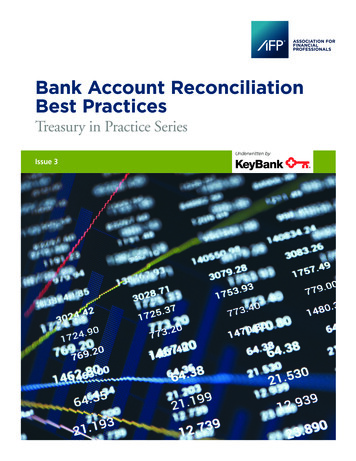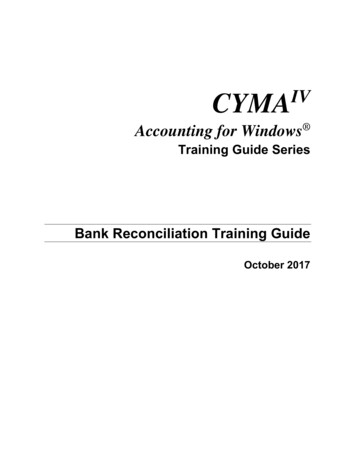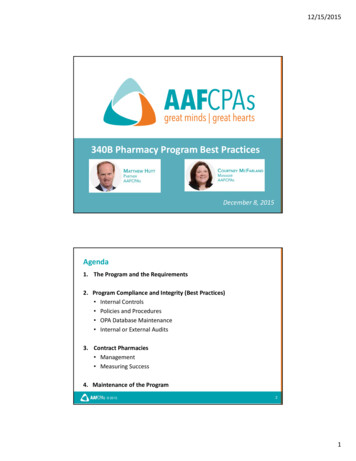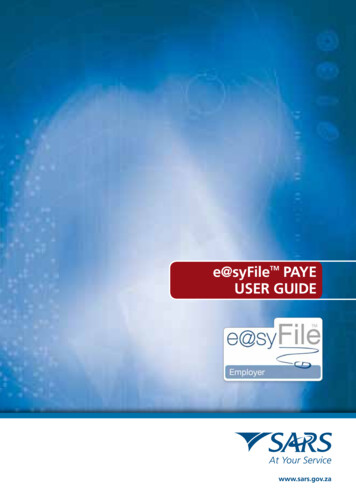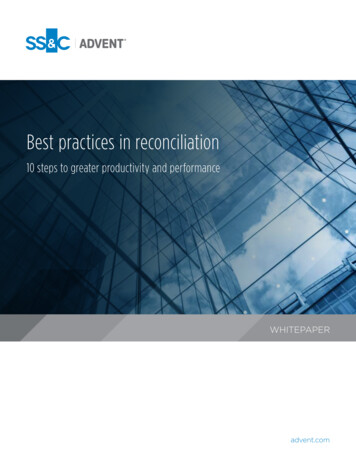
Transcription
Best practices in reconciliation10 steps to greater productivity and performanceWHITEPAPERadvent.com
The decision to automate reconciliation presents botha challenge and an opportunity for firms: a challenge tostay competitive and an opportunity to make dramaticimprovements in efficiency and client service.The secret success ingredientReconciliation is an often overlooked andundervalued activity, seen as a mundane—albeit necessary—function best avoided.Done right, reconciliation is crucial to twoof the most important determinants ofyour organization’s success: front-officeperformance and client satisfaction.Unfortunately, reconciliation at many firmsremains a laborious, time-consuming andrisk-laden process, where staff are forcedto trawl through reams of spreadsheetsand tick off every transaction manually.This approach is inefficient andunsustainable, severely limiting firms’ability to compete.Automating reconciliation processes andimplementing exception-based workflowbest practices offers firms easy wins in thequest for greater productivity,performance, efficiency and profitability.Plucking this low-hanging fruit today is asimple and obvious way to position yourfirm to prosper in whatever marketconditions the future may hold.This document explains why automatedreconciliation is quickly evolving into acompetitive necessity. It details the costsand risk associated with manualreconciliation and the benefits to begained from automation. It also outlines a10-point checklist for optimizingreconciliation process efficiency, andweighs the pros and cons of alternativesolutions—in-house, third party or webhosted.Ultimately, the decision to automatereconciliation presents both a challengeand an opportunity for firms: a challengeto stay competitive, and an opportunity tomake dramatic improvements in efficiencyand client service.High cost of manualreconciliationtime-consuming and tedious process—especially since investment managerstypically have multiple custodians andother service providers. Not only does thetask divert staff time and attention fromhigher value activities, but it is liable toresult in unnecessary expense, significantmistakes, customer frustration,reputational damage, missed investmentopportunities, and potentially evencompliance problems and regulatory fines.Automation has become imperative forthe asset management industry. Apowerful combination of forces—challenging economic conditions,increasing trading volumes, intense andglobalized competition, a growing onuson transparency and greater regulatoryscrutiny—are creating ever more demandsfor accurate and timely reconciliation. Andwith daily reconciliation now seen asindustry best practice, and real-timereconciliation on the horizon, thosepressures continue to escalate.Yet all too often the trade and portfolioreconciliation process between an assetmanager and its various counterparties, aswell as internally within the firm, remainslabor intensive, error prone and costly.Reconciling those external and internaldata flows by manually “ticking and tying”each transaction and position record is a2 Best practices in reconciliation: 10 steps to greater productivity and performanceAutomating reconciliationprocesses, and implementingexception-based workflow bestpractices offers firms easy winsin the quest for greaterproductivity, performance,efficiency and profitability.
A powerful combination of forces—challenging economicconditions, increasing trading volumes, intense andglobalized competition, a growing onus on transparencyand greater regulatory scrutiny—are creating ever moredemands for accurate and timely reconciliation.Non-automatedreconciliation: The pain pointsAny breakdown in the automation chainwill impact your firm’s resources and riskprofile. These costs and risks may take theform of: Exposure to operational risk fromunmatched items. Account errors that mean portfoliomanagers don’t have an accuratepicture of how much cash or securitiesthey have available with which to trade. A month-end reconciliation cycleresulting in day-to-day investmentdecisions being based on old orinaccurate data. A period-end reporting fire-drill focusedon “getting reports out the door” ratherthan on producing them correctly in acontrolled and predictable manner. A temptation to “plug in” data just tomake it reconcile. Poor client service, with its impact onclient and asset retention. Staff time that could be spent on morevalue-added functions. Employee discontent and turnover fromlower job satisfaction. Lack of operational scalability to meetchanges in business volumes and takeadvantage of growth opportunities. Inaccurate performance numbers,potentially raising compliance concerns.The business upside:Five competitive advantagesfrom automationThe asset management industry is facing atougher economic, investor and regulatorylandscape that will intensify competitionbetween industry participants. As a newreport by consultancy Casey Quirkobserves1, rather than simplyoutperforming similar-looking firms withsimilar value propositions, successfulplayers will win by competing throughdifferentiation.How can firms achieve that differentiation?The simple answer is satisfied clients.Increasingly inflows will go to those firmsthat can combine investment performancewith strong client service and a reputationfor trust and reliability. Asset managers thatexcel at communicating their strategies areoften successful in retaining assets, evenwhen their investment returns are less thanstellar. Satisfied clients are also more likelyto invest additional sums in that manager’sfunds.Reconciliation has a central role to play inachieving those goals. The quickeningpace of the market and more demandingclient expectations have made highquality reconciliation a competitivenecessity. Replacing an error-prone,manual file-matching process or creakylegacy system with a time-saving, accurateand automated environment offerssignificant advantages on multiple fronts.1—Informed investment decisionsActionable information, delivered viauser-friendly dashboards, is also thecornerstone of effective front officedecision-making.Portfolio managers and traders depend onup-to-date cash balances, transactiondetails and portfolio positions—derivedfrom timely, accurate, reconciled data—to make better investment decisions andminimize the firm’s risk exposure.For example, having more cash than theythought could result in portfolio managersmissing trading opportunities andunderperforming their benchmark. Orwhere a position is misvalued they may failto hedge the exposure properly.2—Increased productivity andbusiness growthManual reconciliation processes that tookdays or weeks can be done in hours byleveraging an automated, exceptionbased reconciliation solution. Staffpreviously devoted to mind-numbingticking and tying can be empowered tofocus on more energizing, higher-valuefunctions in operations, client service andother areas of the company, which canhelp to grow the business, increaserevenues and streamline costs.13 Best practices in reconciliation: 10 steps to greater productivity and performanceThe Roar of the Crowd: How Individual InvestorsTransform Competition in Asset Management,November 2015, Casey Quirk
Portfolio managers and traders depend on up-todate cash balances, transaction details and portfoliopositions—derived from timely, accurate, reconcileddata—to make better investment decisions and minimizethe firm’s risk exposure.Moreover, because systems can handlethe reconciliation process faster and withfewer errors, firms’ operationsdepartments do not have the same scaleconstraints. As a result, they can supportgreater volumes—from increased trading,new client acquisition or new lines ofbusiness—without having to ramp upstaffing levels.3—Improved client serviceClients are demanding more and betteraccess to relevant data. Sophisticatedclient reporting in particular has becomean essential part of the customerexperience—as seen with the emergenceof interactive portals.Attracting new clients and retainingexisting ones depends on cutting edgetechnology that allows you the flexibilityto service investors how they want to beserviced. We all now expect access tofinancial account information andinvestment insights on any device,whenever and wherever we are. And weexpect that information to be current anderror-free. Having to inform clients thattheir account details are wrong, or that theinvestment performance must be restateddue to data errors is not a recipe forsatisfied customers.Similarly, providing portals for internalusers has become an important part ofthe service mix. For example, equippingrelationship managers with mobile,interactive tools allows them to betterengage with their end clients while on theroad—including by sharing accountinformation, reviewing and revisinginvestment strategies, and creatingopportunities to cross-sell relevantproducts and services.However, before clients see that data it hasto be cleaned and checked—and thatmeans properly reconciled, using a strongworkflow, at least daily.4—Service delivery controlBy automating the reconciliation process,and switching to an exceptions-basedenvironment, firms can gain enhancedvisibility into their counterparties’ servicedelivery, and identify where processimprovements can be achieved.With the aid of sophisticated investigativetools and reporting capabilities,management can track where breaks occur.Armed with intelligent insights into theirbusiness and counterparty interactions, andthe quality of service they receive, firmsthen have the power to review—andwhere appropriate renegotiate—agreements with their service providers.5—Enhanced complianceAn automated reconciliation andexception management system reduceserrors and operational risk, ensuresstandardized procedures, and maintainsaccurate activity records and audit trails forregulatory reporting. A firm that fullyautomates its processes is in a muchbetter position to demonstratecompliance when required, and keep pacewith ever tightening and more complexregulatory requirements.4 Best practices in reconciliation: 10 steps to greater productivity and performanceThe quickening pace of the marketand more demanding clientexpectations have made highquality reconciliation a competitivenecessity.
Figure 1: Custodian reconciliationCOLLECTCOMPAREDETERMINECompare custodiantransactions with primarysource maintained in theportfolio management systemCollect daily transaction andposition data from custodiansDetermine reconciliation actionfor unmatched exceptionsFigure 2: Broker reconciliationMATCHMatch tradeallocations to brokerrecordIDENTIFYAFFIRMIdentify and addressexceptionsUPDATEAffirm matched trades(if an affirming party)Update internalsystemsBest practice workflowmodelAutomating the reconciliation process canbring significant benefits—provided theright solutions and processes are adopted.So what does implementation of a bestpractices reconciliation environmententail?The first step is to identify the variousstages needed in the reconciliationworkflow. There is no “one size fits all”process, since different asset managershave different needs. However, most firmsimplement some form of custodianreconciliation, as that is the last checkbefore sending out client reports(Figure 1).In addition, some firms opt for a greaterlevel of scrutiny by self-affirming, addingbroker reconciliation to their workflow sothey can catch and control issues furtherupstream (Figure 2).Once the specific workflow stages havebeen identified, firms can focus on makingeach operate as efficiently as possible, andthereby ensure the whole reconciliationprocess runs smoothly.5 Best practices in reconciliation: 10 steps to greater productivity and performanceThe reconciliation workflow can also beapplied to any area where there ispotential for data discrepancies. This couldinclude conducting NAV reconciliationwith a fund administrator, or reconcilingother internal systems, such as theportfolio management system (PMS) withthe order management system (OMS).Whatever process you adopt, regulatorsadvise you to fully understand your areasof risk so you can design policies andprocedures to limit exposure.
Implementing an effective reconciliation environmentrequires a solution that can capture, validate, match andreconcile data between your portfolios and a wide rangeof external parties.Automating reconciliation:10 steps to greater efficiencyOnce the best practices have beenidentified and established, the next step isto introduce appropriate technology toautomate each step of the workflow puzzle.Implementing an effective reconciliationenvironment requires a solution that cancapture, validate, match and reconcile databetween your portfolios and a wide rangeof external parties. And when breaksoccur, a sophisticated solution will assistthe exception management process byautomating as many functions as possible,thereby increasing efficiency, cutting costsand reducing errors.Key capabilities to look for whenconsidering a reconciliation ITframework are:1. Flexible data capture with automatedaccess to two unique sources ofaccount activity: Primary: Internal source (such as dataheld in your order managementsystem). Secondary: External source (such ascustodial data aggregation service,clearing house, custodian website).2. Centralized electronic data collection,aggregation and normalization fromthe widest possible universe ofcounterparties, with daily connectivityand the ability to deal with multiple filetypes.3. Immediate transaction amendmentcapability, enabling staff to add orreplace data and track exceptions.4. One-time mapping configurability toautomate rudimentary or recurringsteps of data collection and processing,enabling the user to focus solely onexception management.5. Customizable rules-based matchingengine with user-defined tolerances.6. Sophisticated investigative tools toidentify exception root causes, andaggregate similar exceptions forlong-term resolution.7. Automatic exception prioritization andassignment to ensure staff remainfocused on areas of greatest impact,with the ability to mark and set asidepending items to be resolved later (forinstance if reconciling after a re-org orif the custodian is late in reporting).6 Best practices in reconciliation: 10 steps to greater productivity and performance8. Management dashboards,customizable by role, to provide a clearview of critical, enterprise-wide data,including breaks by portfolio, group,date, age or other criteria.9. Production and efficient distribution ofeasy-to-read, high quality reports toprovide full visibility into cash,holdings, transactions, trial balancesand security masters.10. Audit trail support to record all actionsundertaken during the reconciliationprocess.Technology deployment optionsWhen it comes to implementing a bestpractice reconciliation framework, assetmanagers can choose from three broadoptions: Build—Use internal resources to designand build a solution. Buy—Purchase commercially availabletechnology. Outsource—Hand off the process to athird party.Whichever option you choose, it is vital todedicate your technological and businessresources to those strategic differentiatorsthat will provide the greatest competitiveadvantage.
Figure 3: Technology deployment optionsBuildProsCons Develop the specification to meet thefirm’s exact needs Costs of using internal technical and business expertise intechnology development Full control of the solution’s futuredestiny Potential lack of expertise Risk of deployment delays, resulting in outdated solution Ongoing maintenance expense and need to keep pacewith market, regulatory and technology evolutions Distraction from coreBuyOutsource Leverage proven solution, built byexperts Cost of purchase and implementation, and ongoingmaintenance Benefit from pooled R&D in futuresystem development Deployment lag time In-house customization potential Need for future upgrades Avoid large, upfront capital investment Ongoing contract fee Leverage IT and business expertise Perceived lack of control and data access In-house IT staff costs Rapid deployment Immediate access to updatedfunctionality as it becomes available Provider is responsible for keeping pacewith market and regulatory changesA case studyA 1 billion U.S.-based asset managementfirm had one person doing all itsreconciliation manually at month-endusing paper custodial statements andsome online tools.With about 850 accounts, the process tookmore than a week. It meant investmentdecisions were made based on stale andpotentially inaccurate data. And whenerrors occurred they might not come tolight until well after month-end, causing aripple effect of problems in the meantime.The firm decided to implement straightthrough processing technology toautomate the connections and integratedata between its systems and externalparties such as custodians, brokers andsecurities data providers.This enabled the asset manager toautomate its trading, settlement andaccount reconciliation.Without having to increase staff, everyaccount is now reconciled daily, and aprocess that took more than a week has7 Best practices in reconciliation: 10 steps to greater productivity and performancebeen cut to approximately three hours.Exceptions are uncovered immediately. Bynoon, clients can get accurate positions asof the previous day’s end. And portfoliomanagers and traders know they areworking with the most current, accuratedata available.
While automation in itself may be no guarantee ofsuccess, a scalable and repeatable process will providethe foundation for stability and growth—and a measureof protection against market uncertainty.Meeting the challenge,seizing the opportunityIn the face of soaring trade volumes,increasingly complex transactions andmounting pressure for faster reconciliation,investment management firms today faceboth a challenge and an opportunity. Thechallenge is to meet the growing marketdemand for accurate, real-timereconciliation regardless of volume levels.The opportunity is to increase efficiency,eliminate error-prone manual intervention,and reduce the labor and infrastructurecosts associated with reconciliation.Fortunately, technological solutions existthat enable a firm to both meet thechallenge and seize the opportunity.Introducing automated processeswherever possible across an enterprise’soperations—with all the cost reduction,error minimization and scalabilityadvantages automation brings —is one ofthe most effective ways for industryparticipants to gird themselves forwhatever changes and challenges lieahead. While automation in itself may beno guarantee of success, a scalable andrepeatable process will provide thefoundation for stability and growth—anda measure of protection against marketuncertainty.advent.com info@advent.com 2016 SS&C Technologies Holdings, Inc. WP-020-AD
gained from automation. It also outlines a 10-point checklist for optimizing reconciliation process efficiency, and weighs the pros and cons of alternative solutions—in-house, third party or web hosted. Ultimately, the decision to automate reconciliation presents both a challenge and an opportunity for firms: a challenge
